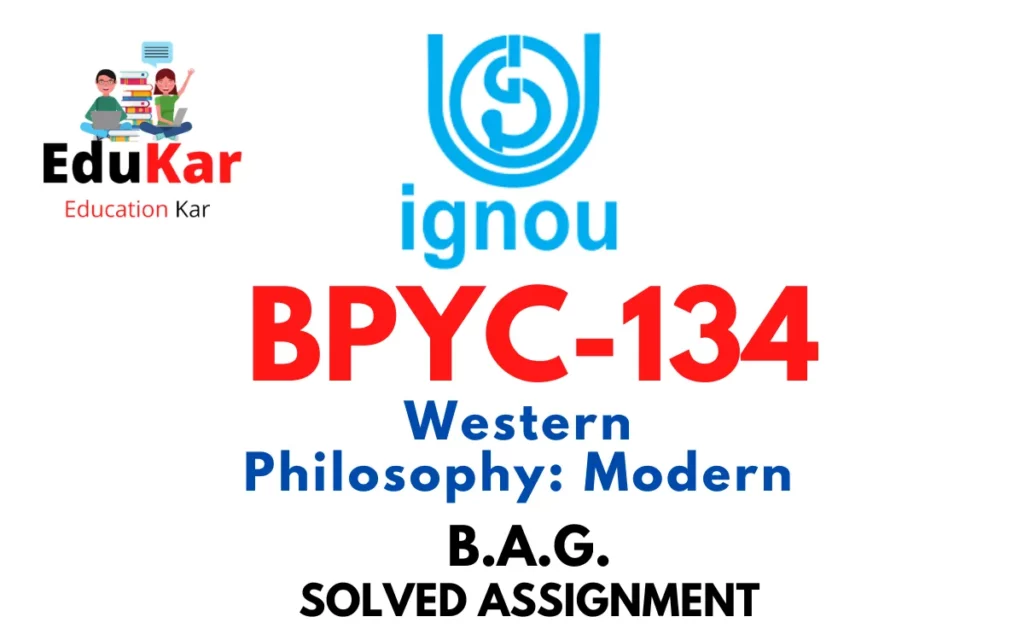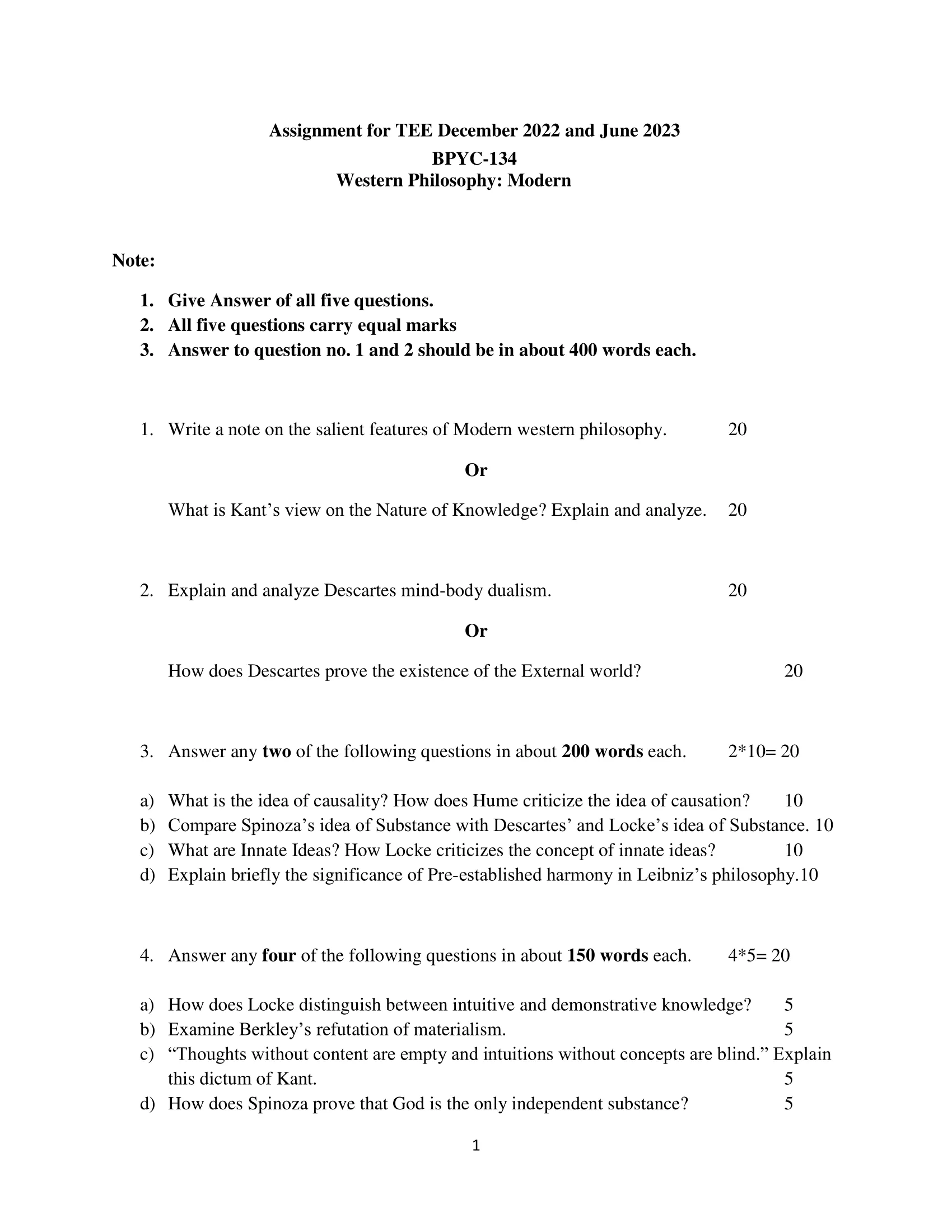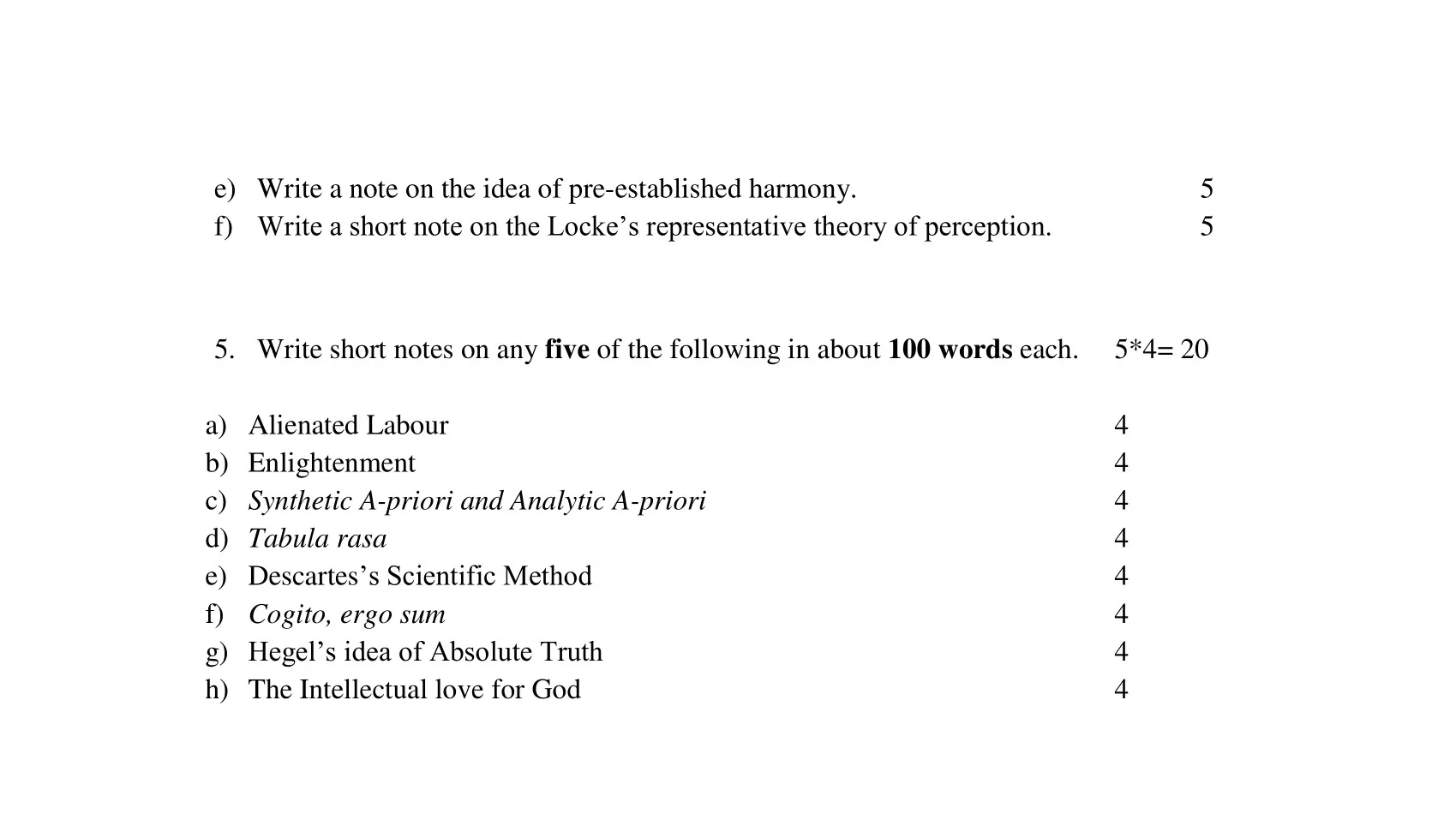Contents
- 1 1. Write a note on the salient features of Modern western philosophy.
- 2 2. Explain and analyze Descartes mind-body dualism.
- 3 Answer any two of the following questions in about 200 words each.
- 4 a) What is the idea of causality? How does Hume criticize the idea of causation?
- 5 b) Compare Spinoza’s idea of Substance with Descartes’ and Locke’s idea of Substance.
- 6 c) What are Innate Ideas? How Locke criticizes the concept of innate ideas?
- 7 d) Explain briefly the significance of Pre-established harmony in Leibniz’s philosophy.
- 8 Answer any four of the following questions in about 150 words each.
- 9 a) How does Locke distinguish between intuitive and demonstrative knowledge?
- 10 b) Examine Berkley’s refutation of materialism.
- 11 c) “Thoughts without content are empty and intuitions without concepts are blind.” Explain this dictum of Kant.
- 12 d) How does Spinoza prove that God is the only independent substance?
- 13 e) Write a note on the idea of pre-established harmony.
- 14 f) Write a short note on the Locke’s representative theory of perception.
- 15 Write short notes on any five of the following in about 100 words each.
- 16 a) Alienated Labour
- 17 b) Enlightenment
- 18 c) Synthetic A-priori and Analytic A-priori
- 19 d) Tabula rasa
- 20 e) Descartes’s Scientific Method
- 21 f) Cogito, ergo sum
- 22 g) Hegel’s idea of Absolute Truth
- 23 h) The Intellectual love for God

| Title | BPYC-134: IGNOU BAG Solved Assignment 2022-2023 |
| University | IGNOU |
| Degree | Bachelor Degree Programme |
| Course Code | BPYC-134 |
| Course Name | Western Philosophy: Modern |
| Programme Name | Bachelor of Arts (General) |
| Programme Code | BAG |
| Total Marks | 100 |
| Year | 2022-2023 |
| Language | English |
| Assignment PDF | Click Here |
| Last Date for Submission of Assignment: | For June Examination: 31st April For December Examination: 30th September |


1. Write a note on the salient features of Modern western philosophy.
Ans: Modern Western philosophy refers to a philosophical tradition that began in the early modern period and continues to the present day. Modern Western philosophy is characterized by a focus on the individual and the human experience, a rejection of traditional authority, and an emphasis on reason and empirical observation.
Here are some salient features of modern Western philosophy:
- Rationalism: Rationalism is the idea that knowledge can be gained through reason and logic, rather than through sensory experience. Rationalist philosophers, such as Rene Descartes, believed that the human mind has the innate ability to discover fundamental truths about the world.
- Empiricism: Empiricism is the idea that knowledge comes from sensory experience. Empiricist philosophers, such as John Locke and David Hume, believed that the mind is a blank slate at birth and that all knowledge comes from experience.
- Skepticism: Skepticism is the view that knowledge is uncertain and that it is difficult, if not impossible, to be certain about anything. Skeptical philosophers, such as Michel de Montaigne and Friedrich Nietzsche, believed that we should question everything and be open to the possibility that our beliefs may be wrong.
- Individualism: Modern Western philosophy places a strong emphasis on the individual and the human experience. Philosophers such as Jean-Jacques Rousseau and Immanuel Kant believed that individuals have the ability to reason and make choices for themselves, and that this ability is what makes us human.
- Naturalism: Naturalism is the idea that the natural world is all that exists, and that everything can be explained by natural causes. Naturalist philosophers, such as Baruch Spinoza and Benedict de Spinoza, believed that the natural world is governed by natural laws and that everything can be explained by science.
- Secularism: Secularism is the view that religion should have no place in the public sphere. Secular philosophers, such as Voltaire and John Stuart Mill, believed that religion was a private matter and that the state should be neutral with regard to religion.
- Existentialism: Existentialism is the philosophy that emphasizes individual freedom and choice. Existentialist philosophers, such as Jean-Paul Sartre and Albert Camus, believed that individuals create their own meaning in life and that we must face the absurdity of existence and create our own values.
2. Explain and analyze Descartes mind-body dualism.
Ans: René Descartes, a 17th-century philosopher, posited a theory known as mind-body dualism. According to Descartes, the mind and body are distinct entities, with the mind being an immaterial and non-extended substance, while the body is a material and extended substance. This theory has been one of the most significant contributions to the philosophy of mind and has inspired much debate and discussion over the centuries.
Descartes’ dualism was influenced by his skepticism about the reliability of our sensory experiences. He believed that our senses could deceive us, and therefore, we needed a foundation for knowledge that was not based on sensory experience. Descartes argued that the only thing we can be certain of is that we are thinking, and from this, he concluded that the mind and body are separate substances.
Descartes argued that the mind and body interacted in the pineal gland, a small structure in the brain. He believed that the mind could influence the body and vice versa, but that the two were fundamentally different. The mind was responsible for thought, consciousness, and other mental phenomena, while the body was responsible for physical sensations, movements, and other bodily functions.
Critics of Descartes’ theory have raised several objections. One of the most significant criticisms is the problem of how the mind and body can interact if they are fundamentally different substances. Descartes’ explanation of the pineal gland as the point of interaction has been dismissed by many as inadequate. Others have criticized Descartes’ dualism as being too simplistic, and failing to capture the complex relationship between the mind and body.
Despite these criticisms, Descartes’ theory of mind-body dualism has had a lasting impact on the philosophy of mind. It has influenced many subsequent theories, including materialism, idealism, and functionalism. Descartes’ dualism also laid the groundwork for the scientific study of the mind, as it distinguished mental phenomena from physical phenomena, and suggested that the mind could be studied independently of the body.
Descartes’ mind-body dualism theory is one of the most significant contributions to the philosophy of mind. Although it has been subject to many criticisms, it has had a lasting impact on the study of the mind and has inspired many subsequent theories. The problem of how the mind and body can interact remains an open question, and the debate over the nature of the mind and its relationship to the body continues to be a topic of intense discussion among philosophers and scientists alike.
Answer any two of the following questions in about 200 words each.
a) What is the idea of causality? How does Hume criticize the idea of causation?
Ans: The idea of causality is the notion that there is a necessary connection between two events or phenomena, such that one event or phenomenon is responsible for bringing about the other. In other words, causality is the relationship between cause and effect, where the cause is what makes the effect happen.
David Hume, a Scottish philosopher, criticized the idea of causation in his work “An Enquiry Concerning Human Understanding.” Hume argued that causality is not a property that can be observed in the world, but rather a mental construct that humans impose on the world in order to make sense of it. He claimed that there is no way to observe causality itself, but only the sequence of events, and that we cannot deduce the necessary connection between them.
Hume also pointed out that there is no logical reason to conclude that the cause and effect relationship will continue to hold true in the future. He argued that all we can ever know is that two events or phenomena are regularly associated with each other, but we cannot infer that one causes the other.
Hume’s criticisms of causation were significant because they challenged the way people thought about the world and the limits of human knowledge. His ideas influenced subsequent philosophers and scientists, including Immanuel Kant, who attempted to reconcile Hume’s skepticism with the notion of causality as a necessary component of human reasoning.
b) Compare Spinoza’s idea of Substance with Descartes’ and Locke’s idea of Substance.
Ans: Spinoza, Descartes, and Locke were three prominent philosophers of the modern period who each had their own ideas about substance.
Spinoza’s idea of substance was monistic and pantheistic. He believed that there is only one substance, which he identified as God or Nature, and that all other things are just attributes of this substance. For Spinoza, substance is the only thing that truly exists and everything else is just a mode or modification of substance.
Descartes, on the other hand, had a dualistic view of substance. He believed that there are two substances in the world: the material substance of the body and the immaterial substance of the mind or soul. For Descartes, substance is that which exists independently of anything else and can be known through clear and distinct ideas.
Locke’s view of substance was empiricist. He believed that substance is a hypothetical construct that we use to explain the observable properties of things. According to Locke, we do not have direct access to substance, but we can infer its existence from the properties that we observe.
c) What are Innate Ideas? How Locke criticizes the concept of innate ideas?
Ans: Innate ideas are ideas or concepts that are supposedly present in the mind at birth, prior to any experience. The concept of innate ideas has been present in the history of philosophy since the time of Plato, and was further developed by philosophers such as Descartes and Leibniz.
John Locke, an influential 17th-century philosopher, was highly critical of the concept of innate ideas. He argued that the mind is a blank slate, or “tabula rasa,” at birth, and that all knowledge comes from sensory experience. According to Locke, the mind has no innate ideas, but rather receives all of its ideas through sensory experience.
Locke’s criticism of innate ideas is based on several arguments. First, he argued that there is no evidence for the existence of innate ideas. He pointed out that if innate ideas existed, everyone would be born with the same set of ideas, which is clearly not the case.
Second, Locke argued that the concept of innate ideas is unnecessary to explain the acquisition of knowledge. He believed that sensory experience is sufficient to account for all of our knowledge, and that the mind does not need to have any innate ideas to make sense of the world.
Finally, Locke argued that the concept of innate ideas is dangerous, as it can be used to justify authoritarianism and dogmatism. He believed that if people believe that certain ideas are innate, they may be less likely to question those ideas or to be open to new experiences and knowledge.
d) Explain briefly the significance of Pre-established harmony in Leibniz’s philosophy.
Ans: Pre-established harmony is a key concept in the philosophy of Gottfried Wilhelm Leibniz, a German philosopher and mathematician of the 17th and 18th centuries. According to Leibniz, pre-established harmony is the idea that there is no causal interaction between mind and body, but rather a pre-established agreement that they will always be in harmony with one another.
Leibniz believed that the mind and body are fundamentally different types of substance, with the mind being immaterial and the body being material. He also believed that God created the world in such a way that the mind and body are pre-programmed to always work together in perfect harmony, without any direct interaction between the two.
This concept is significant in Leibniz’s philosophy because it allows him to reconcile the mind-body problem, which is the problem of explaining how an immaterial mind can interact with a material body. By positing pre-established harmony, Leibniz is able to account for the fact that the mind and body seem to interact without resorting to the idea that the mind causes bodily movements or vice versa.
Additionally, the concept of pre-established harmony plays a role in Leibniz’s overall metaphysical system, which emphasizes the existence of a pre-established order in the universe. Leibniz believed that everything in the universe, from the smallest particles to the most complex organisms, is part of a harmonious whole that reflects the will of God.
Answer any four of the following questions in about 150 words each.
a) How does Locke distinguish between intuitive and demonstrative knowledge?
Ans: Intuitive knowledge, according to Locke, is knowledge that is immediately grasped without any need for reasoning or inference. It is self-evident and undeniable, and it is the most certain type of knowledge. Examples of intuitive knowledge include the knowledge that something cannot be both A and non-A at the same time, and that the whole is greater than any of its parts.
Demonstrative knowledge, on the other hand, is knowledge that is obtained through reasoning and inference. It involves taking certain propositions or axioms as starting points and then using them to derive other truths. Demonstrative knowledge is less certain than intuitive knowledge, but it is still highly reliable. Examples of demonstrative knowledge include mathematical and logical proofs.
b) Examine Berkley’s refutation of materialism.
Ans: George Berkeley, an 18th-century philosopher, was a critic of materialism and held a view called “immaterialism” or “idealism”. He rejected the notion of the material world as being an independent reality outside of the mind.
Berkeley’s refutation of materialism can be summarized in the following way: all objects of our perception are ideas in the mind, and there is no existence of an external, material world that exists independently of our perceptions.
Berkeley argues that the materialist belief in an external world is grounded on a flawed assumption that there is an object distinct from perception. According to Berkeley, we can only know objects through their perceptual qualities, such as colors, sounds, textures, and so on. Since these perceptual qualities are themselves mental, Berkeley argues that there is no justification for positing an external, material reality.
c) “Thoughts without content are empty and intuitions without concepts are blind.” Explain this dictum of Kant.
Ans: The statement “thoughts without content are empty and intuitions without concepts are blind” is a famous dictum by Immanuel Kant, an influential 18th-century philosopher. According to Kant, both our thoughts and intuitions are necessary for us to gain knowledge of the world.
Kant believed that thoughts without content are empty, meaning that ideas or concepts that are not grounded in experience have no value. For example, a concept like “unicorn” may be a thought, but it is empty because it lacks any connection to reality.
On the other hand, intuitions without concepts are blind, meaning that sensory experiences that are not accompanied by concepts or ideas are meaningless. For example, seeing colors or shapes without any ability to conceptualize or understand them would be a “blind” intuition.
Kant argued that the mind needs both thoughts and intuitions to gain knowledge, as concepts provide a framework for organizing sensory experience and making sense of the world. Therefore, for Kant, the best way to gain knowledge is to have experiences that are grounded in concepts, allowing us to understand and learn from the world around us.
d) How does Spinoza prove that God is the only independent substance?
Ans: In his philosophy, Baruch Spinoza defines substance as something that exists in itself and is conceived by itself, independently of anything else. For Spinoza, there can only be one substance because if there were more than one substance, then they would have to be different in some way, and any differences between substances would make them dependent on each other.
Spinoza also believes that God is the only substance. He defines God as the infinite and eternal substance that includes everything that exists. According to Spinoza, God is the only independent substance because all other things that exist are merely modes or expressions of God. In other words, everything that exists is a manifestation of God, and nothing can exist outside of God.
e) Write a note on the idea of pre-established harmony.
Ans: The idea of pre-established harmony is a philosophical concept that was first proposed by the 17th-century philosopher Gottfried Wilhelm Leibniz. According to Leibniz, the world is composed of a multitude of substances, each of which has its own internal nature or essence. These substances are not causally connected to each other, but rather operate according to their own individual laws.
Leibniz believed that even though these substances do not interact with each other causally, they are in harmony with each other by virtue of being created and designed by God. God, as the ultimate designer and creator of the universe, established a pre-existing harmony between all of the substances in the world, so that they work together in perfect synchronization.
f) Write a short note on the Locke’s representative theory of perception.
Ans: John Locke’s representative theory of perception, also known as indirect realism, is a philosophical theory that suggests that we do not have direct access to the external world, but rather we perceive it through our senses.
According to Locke, our perception of the world is mediated by our senses. He believed that the mind is a blank slate or “tabula rasa,” and that all knowledge comes from experience. He argued that when we perceive an object in the external world, we do not directly perceive the object itself, but rather we perceive its qualities or properties, such as color, shape, and texture.
Locke’s theory suggests that the mind constructs mental representations or “ideas” based on the information received from the senses. These ideas are then used to form our perception of the world. Therefore, our perception of the world is not a direct reflection of the world itself, but rather a mental representation of it.
Write short notes on any five of the following in about 100 words each.
a) Alienated Labour
Ans: The concept of alienated labor was developed by the German philosopher, Karl Marx. According to Marx, alienated labor is a state in which workers become estranged from the products of their labor, from the process of labor, and from their own nature as human beings.
Marx argued that the capitalist system is responsible for creating alienated labor. Under capitalism, workers are forced to sell their labor as a commodity to capitalists who own the means of production. Workers do not own the products of their labor, nor do they have control over the process of production. The result is that workers become disconnected from their own labor, which becomes a means of survival rather than a fulfilling activity.
b) Enlightenment
Ans: The Enlightenment was an intellectual and cultural movement that took place primarily in Europe during the 17th and 18th centuries. It was characterized by a strong emphasis on reason, scientific inquiry, individual liberty, and progress.
During the Enlightenment, thinkers and philosophers challenged traditional beliefs and authority, and sought to create a more rational and scientific understanding of the world. They emphasized the importance of empirical evidence and critical thinking, and sought to free individuals from the constraints of tradition and superstition.
c) Synthetic A-priori and Analytic A-priori
Ans: The concepts of synthetic a-priori and analytic a-priori were first introduced by Immanuel Kant, a German philosopher, in his work “Critique of Pure Reason.”
Analytic a-priori propositions are those that are self-evident and true by definition, and their truth does not depend on experience. For example, “All bachelors are unmarried” is an analytic a-priori statement because the concept of a bachelor already contains the idea of being unmarried.
On the other hand, synthetic a-priori propositions are those that are not self-evident and require experience to be known. They go beyond what is contained in the definition of the subject and predicate. For example, “The sun will rise tomorrow” is a synthetic a-priori statement because its truth cannot be known by definition alone, but requires empirical observation.
d) Tabula rasa
Ans: Tabula rasa is a philosophical concept that was developed by the 17th-century English philosopher John Locke. The term “tabula rasa” is Latin for “blank slate,” and refers to the idea that the human mind is born without any innate knowledge or ideas, and is instead like a blank slate that is gradually filled with knowledge and experience through perception and sensation.
e) Descartes’s Scientific Method
Ans: The scientific method developed by Descartes consists of several key steps, including:
- Doubt: Descartes believed that in order to arrive at certain knowledge, it was necessary to doubt all previously accepted beliefs and opinions, including those based on tradition, authority, and even one’s own senses.
- Analysis: After doubting all beliefs, Descartes recommended breaking down complex problems into smaller parts that could be more easily understood and analyzed.
- Synthesis: Once the problem had been broken down into smaller parts, Descartes recommended synthesizing the parts back together to arrive at a more complete and accurate understanding of the problem.
- Testing: After arriving at a hypothesis or solution, Descartes recommended testing it rigorously through observation and experiment to ensure its validity and accuracy.
- Systematization: Finally, Descartes recommended systematizing the knowledge gained through this process, in order to build a body of scientific knowledge that could be shared and built upon by others.
f) Cogito, ergo sum
Ans: Cogito, ergo sum” is a Latin phrase that translates to “I think, therefore I am.” This phrase is famously associated with the French philosopher and mathematician, René Descartes, who used it as a starting point for his philosophical inquiry into the nature of knowledge and reality.
In his “Meditations on First Philosophy,” Descartes argued that one cannot doubt their own existence, as the act of doubting itself proves that there must be a thinking entity. He used the phrase “cogito, ergo sum” to sum up this argument, suggesting that the very act of thinking is proof of one’s own existence.
g) Hegel’s idea of Absolute Truth
Ans: Hegel believed that history and human consciousness are constantly evolving, and that the dialectical process is the key to understanding the development of both. According to this process, ideas or concepts (thesis) are confronted by their opposites (antithesis), and this leads to a synthesis that incorporates the strengths of both while overcoming their weaknesses.
In Hegel’s view, the Absolute Truth is the result of this dialectical process, as it represents the ultimate synthesis of all opposing ideas and concepts. He argued that this Absolute Truth is not only a matter of intellectual understanding, but it also has a spiritual and ethical dimension.
h) The Intellectual love for God
Ans: The intellectual love for God is a concept developed by the Dutch philosopher Baruch Spinoza, who saw it as the highest form of human knowledge and the key to achieving a state of happiness and contentment.
According to Spinoza, the intellectual love for God is not a sentimental or emotional attachment, but rather a rational understanding of the universe as a whole, which includes the recognition of the unity and interconnectedness of all things.
How to Download BPYC-134 Solved Assignment?
You can download it from the www.edukar.in, they have a big database for all the IGNOU solved assignments.
Is the BPYC-134 Solved Assignment Free?
Yes this is absolutely free to download the solved assignment from www.edukar.in
What is the last submission date for BPYC-134 Solved Assignment?
For June Examination: 31st April, For December Examination: 30th October
















